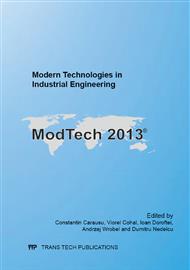p.688
p.694
p.699
p.705
p.711
p.718
p.727
p.733
p.739
The Influence of Thermal Treatment upon Nanostructure and Composition of YZrO Based Ceramics Obtained by Atmospheric Plasma Spraying
Abstract:
This paper presents a concept of thermal barrier coating used to prevent exfoliation and increase the maximum working temperature of a turbine engine. The coating consist of a ZrO2/20%Y2O3 ceramic layer and a NiCrAlY adherent layer, deposited by atmospheric plasma spraying (APS), on a Ni super alloy sample usually used for the manufacturing of turbine blades. The sample was subjected to thermal treatment and after that analyzed. SEM images of the samples were taken, to analyze their behaviour to thermal treatment. . Reference sample (without thermal treatment) and samples subjected to 5, 10 and 15 hours heat treatment were investigated using X-ray diffraction in 25-130o 2θ interval.
Info:
Periodical:
Pages:
711-717
Citation:
Online since:
November 2013
Price:
Сopyright:
© 2014 Trans Tech Publications Ltd. All Rights Reserved
Share:
Citation:


